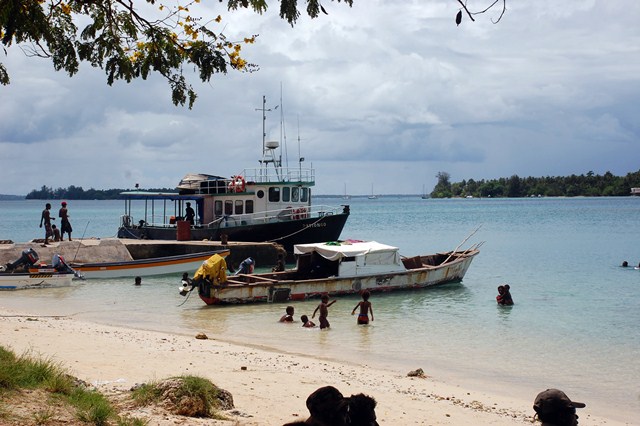The recent 12MC article Small Change, Big Difference created an unusual amount of interest. One comment from reader Ross arrived embedded with a challenge:
“This reminds me of a question I’ve often wondered: Which place changes the most when you add ‘New’ in front of the name? In other words: Which ‘New’ place is the most unlike the place it was named after? My guess: New Britain (the island in Papua New Guinea). It’s hard to imagine a place more unlike ‘Old’ Britain.”
Ross obviously put a lot of thought into his well-educated choice. This example might be the best one around, at least as good as any of the top tier. I thought I would see if I could add some other places to the list for consideration and open the discussion to a broader audience.
New Ireland, Papua New Guinea

Britain had Ireland nearby so I suppose PNG’s New Britain needed a New Ireland nearby too (map). The two were located in close proximity just like their namesakes. Face it, just about anything geographic or climatic in Papua New Guinea would differ considerably from anything in the British Isles. One could select just about any place with a “New” prefix in the tropics and it would score well in this contest.
The New Ireland name in PNG affixed to an island, a string of islands and a province. The largest town on the island of that name, Kavieng, became the capital of the larger province of New Ireland. Fierce fighting occurred here during World War II and wartime relics still appear within the area. Today most visitors come for the military history or to dive on pristine coral reefs located just offshore.
New Ireland used to be New Mecklenburg (Neu-Mecklenburg) which would be equally odd. Maybe it should get extra credit for being distinctly different from two separate European locations. Plus New Guinea differed from Guinea (see 12MC’s Upstart Eclipses Namesake for that story) to add to the distinction even further.
New Amsterdam, Guyana
Those wandering European settlers and merchants sure seemed to enjoy naming tropical locales after their homelands. The same thing happened in Guyana with the town of New Amsterdam (map). The Dutch became the first colonial power in Guyana. So New Amsterdam was integral to their commercial interests.
“New Amsterdam is Guyana’s oldest town, with a rich history. About 1733, the name New Amsterdam was given to a little village that sprang up around Fort Nassau, several miles up the Berbice River. In 1785 it was decided to abandon Fort Nassau and move to the neighbourhood of Fort St. Andries lower down the river at the confluence of the Berbice River and its tributary the Canje River which is now the site of present day New Amsterdam… New Amsterdam, covers about 13.7 square kilometers in area with an estimated population of approximately 35,000.”
New Amsterdam might also deserve bonus points. Not only did it differ considerably from Amsterdam in the Netherlands, it looked nothing like the other New Amsterdam on the tip of Manhattan Island that formed the nucleus of New York City.
New Germany, KwaZulu-Natal, South Africa

I thought this location might be very promising. A handful of German settlements sprouted within South Africa and one of them became New Germany (map).
“The Bergtheil or Bramsche Colonists: In the early 1840’s, just after the colony of Natal had been annexed by the British, the Natal Cotton Company was established. One of its directors, Jonas Bergtheil, went to Germany to attract settlers to Natal to grow cotton for the Company. After much searching, he found a group of people in the area of Bramsche, Osnabrücker Land, Kingdom of Hanover (now in Lower Saxony) who were willing to try their luck in this new colony. The Bergtheil colonists settled in New Germany, Westville, just outside Port Natal (later renamed Durban)…”
Now it looks like any suburb anywhere. It still retained an air of familiarity in spite of its location at the southern tip of Africa.
New Bedford Inlet, Antarctica
It was hard to reconcile the disconnect between Antarctica and temperate climates. I found a “New” location hidden within its folds and I’ll bet there were plenty of others equally out of place. New Bedford Inlet didn’t have an identity until 1940, when “photographed from the air… by members of the United States Antarctic Service (USAS), and named after New Bedford, Massachusetts, the centre of the New England whaling industry in the middle of the 19th century.” It featured a horribly inhospitable locale packed with glaciers and freezing temperatures in Palmer Land. That hardly resembled Massachusetts even during a bad winter.
New Bedford in Massachusetts was in turn named for Bedford in England. New Bedford Inlet didn’t look anything like England, either. Once again I thought this type of nesting deserved extra credit.
A Couple More to Ponder
I found many others. I wanted to mention two more although I won’t elaborate on them much.
- Nobody ever confused New Caledonia (map), a collectivity of France in the Pacific Ocean east of Australia with Caledonia (i.e., Scotland)
- New Washington (map) in the Philippines resembled neither Washington, DC nor the state of Washington in the United States. However they named it for George Washington directly and not for either of those other locations so it probably didn’t count.
Can anyone come up with even more extreme occurrences to add to Ross’ list?

Leave a Reply